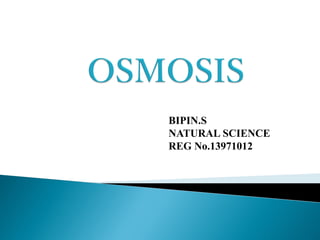
OSMOSIS: A VITAL PROCESS IN BIOLOGICAL SYSTEMS
- 2. Difference in concentration between solutions on either side of semi permeable membrane called Osmotic gradient Osmosis is the spontaneous net movement of solvent molecules through a partially permeable membrane into a region of higher solute concentration, in the direction that tends to equalize the solute concentrations on the two sides. Osmosis provides the primary means by which water is transported into and out of cells
- 3. Concentration gradient Concentration Gradient - change in the concentration of a substance from one area to another. Osmosis Osmosis is the movement of WATER across a semi-permeable membrane At first the concentration of solute is very high on the left. But over time, the water moves across the semi-permeable membrane and dilutes the particles.
- 5. Osmosis – A Special kind of Diffusion Diffusion of water across a selectively permeable membrane (a barrier that allows some substances to pass but not others). The cell membrane is such a barrier. Small molecules pass through – ex: water Large molecules can’t pass through – ex: proteins and complex carbohydrates
- 6. Hypotonic – The solution on one side of a membrane where the solute concentration is less than on the other side. Hypotonic Solutions contain a low concentration of solute relative to another solution.
- 7. Over time molecules will move across the membrane until the concentration of solutes is equal on both sides. This type of solution is called ISOTONIC.
- 8. • Cytoplasm is a solution of water and solids (solutes dissolved in the water). • Water moves into and out of cells because of the different concentrations of the solutes. • Different kinds of cells react differently depending on the solution they are in. • Below are examples of red blood cells in different types of solutions and shows what happened to the red blood cells.
- 10. There is a greater concentration of free water molecules outside the cell than inside so water diffuses into the cell by osmosis and the cell swells up 11
- 11. cell wall cytoplasm and cell membrane vacuole The cell absorbs water by osmosis .... ....but the cell wall stops the cell expanding any more 18
- 12. For osmosis we talk about the potential water molecules have to move – the OSMOTIC POTENTIAL. Distilled water has the highest potential (zero). When water has another substance dissolved in it, the water molecules have less potential to move.The osmotic potential is NEGATIVE.
- 13. The osmotic potential of a cell is known as its WATER POTENTIAL. For animal cells, the water potential is the osmotic potential of the cytoplasm.
- 14. An animal cell with water potential –50 is placed in a solution…
- 15. If the osmotic potential of the solution is less negative than the water potential of the cytoplasm(the solution is hypotonic), net endosmosis will occur, i.e. water will move into the cell from the solution. The result will be haemolysis (the cell will burst) Water potential of cytoplasm = - 50 Osmotic potential of solution= - 20
- 16. If the osmotic potential of the solution is more negative than the water potential of the cytoplasm (the solution is hypertonic), net exosmosis will occur. The result will be crenation (the cell will shrivel up) Water potential of cytoplasm= - 50 Osmotic potential of solution = - 80
- 17. If the osmotic potential of the solution is the same as the water potential of the cytoplasm (the solution is isotonic), there will be no net osmosis. Water potential of cytoplasm= -50 Osmotic potential of solution= -50
- 18. In animal cells, the water potential is equal to the osmotic potential of the cytoplasm, but this is different in plant cells… Plant cells have a cell wall, which exerts an inward pressure when the cell is turgid.This is known as the pressure potential. The water potential of an animal cell is equal to the osmotic potential of the cytoplasm plus the cell wall pressure: W.P.= O.P. + P.P.
- 19. A plant cell with water potential –50 is placed in a solution…
- 20. If the solution is hypotonic, net endosmosis occurs and the cell becomes fully turgid. Water potential of cytoplasm = -50 Osmotic potential of solution = -20
- 21. If the solution is hypertonic, net exosmosis occurs and causes plasmolysis (the cell membrane pulls away from the cell wall.The cell wall stays intact). Water potential of cytoplasm = -50 Osmotic potential of solution = -80
- 22. If the solution is isotonic, no net osmosis occurs.The cell is not plasmolysed, but it is not fully turgid either. Water potential of cytoplasm = -50 Osmotic potential of solution = -50
- 23. Conclusion: Osmosis is a vital process in biological systems, as biological membranes are semi permeable. Osmosis is responsible for the ability of plant roots to draw water from the soil. Osmosis is a vital process in both plants and animals to maintain their own life process.
- 24. Reference: Borg, Frank (2003). "What is osmosis? Explanation and understanding of a physical phenomenon“ Wiley international publications. Kramer, Eric; David Myers. "Osmosis is not driven by water dilution". Trends in Plant Science 18 (4): 195–197. Kosinski, R. J. "Challenging misconceptions about osmosis.". Association for Biology Laboratory Education 30: 63– 87.
